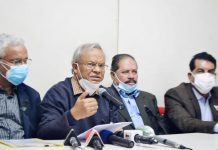Dr. Nizam Uddin Ahmed:
In Bangladesh, the prevailing discourse and initiatives against smoking mainly centre around the negative health impacts of tobacco. But due to tobacco and its products, the profound damage we are doing in the socio-economic field, especially in the economic field, remains invisible. Although there is extensive discussion and activities on the harmful aspects of tobacco in terms of health, we need to highlight more clearly the fact that national health is inextricably linked with economic growth. Especially regarding the consumption of tobacco in national health. In this case, without going into a detailed explanation, only through numerical discussion, the terrible economic degradation caused by tobacco can be highlighted.
In the foremost discussion of Bangladesh Cancer Society’s 2018 study titled ‘The Economic Cost of Tobacco Use in Bangladesh: A Health Cost Approach’, the annual productivity loss due to tobacco use-related illnesses and deaths in the 2017-18 fiscal year was about 22,200 crores.As a result, the economic loss of tobacco use in the fiscal year 2017-18 was 30 thousand 506 crore takas (3.61 billion US dollars), which is equal to 1.4 portions of the total GDP of that year. As of 2018 market value, the total contribution of the tobacco sector to Bangladesh’s GDP in 2016-17 was Tk 22,900 crore. On the other hand, the economic expenditure in this sector is 30 thousand 506 crores. That is, 7 thousand 650 crores less. Even if you look at it from a bird’s eye view, tobacco is seen as a big obstacle to the economic development of Bangladesh. According to the data found in this research, about 1 lakh 26 thousand people died in Bangladesh in 2018 due to the use of tobacco products. In the same year, about 1.5 million adults suffered from tobacco-related diseases and about 61,000 children suffered from various diseases due to second-hand smoke. The total expenditure on the health sector due to the use of tobacco and tobacco products alone was about 8 thousand 4 billion takas, of which 76 percent of the cost was met by the families of tobacco users and 24 percent of the cost came from the budget of the public health sector, which is about 9 percent of the government expenditure on the health sector in the fiscal year 2018-19. Meanwhile, according to research data from the Health Economics Unit, 8.6 million new people fall into poverty every year to meet medical expenses. Worse, every 5 million people in Bangladesh are falling below the poverty line just to meet medical expenses, the majority of which are for non-communicable diseases like tobacco.
Meanwhile, the picture of tobacco users in the country is ominous. According to the Global Adult Tobacco Survey (GATS) 2017, the total number of people using tobacco in the country is 3.78 million. Most of these users belong to the economically backward population. When these poor people get sick, it becomes very difficult to meet their medical expenses. Medical expenses relatedto smoking-related diseases push millions of families into financial crisis and dire poverty every year. User households spend a large portion of their annual income on tobacco products. In the case of marginal poor users, a large portion of people’s income due to tobacco use goes into tobacco companies’ pockets. Which critically weakens the financial capacity of the family.
Tobacco is also emerging as a major threat to the country’s food security. According to the Food and Agriculture Organization of the United Nations, according to the official estimates of 2020 in Bangladesh, 85 thousand 852 tons of tobacco leaves are produced on 40 thousand 472 hectares of land. According to the data of the World Bank, according to the government estimates of 2020 in Bangladesh, 4 thousand 901 kg of food grains have been produced per hectare of land. Then the food security system of the country could have been strengthened by producing 2 lakh 18 thousand 647 tons of food grains instead of 85 thousand 852 tons of tobacco leaves in 2020 itself. According to the data of Bangladesh Institute of Development Studies (BIDS), nearly 90 percent of Bandarban’s land is under tobacco cultivation. There is an extreme food shortage due to excessive tobacco cultivation. This crisis can be removed by cultivating food grains in these lands. According to Bangladesh Bureau of Statistics data, Kurigram, Gaibandha, Nilphamari, Rangpur, Bandarban, and Khagrachari are the top poorest districts in the country. According to the data of BIDS, a large amount of tobacco is cultivated in these districts. Although tobacco companies promote tobacco farming as profitable, it turns out that the districts that are leading in tobacco cultivation are at the top of the poverty line.
The government has to spend much more on the treatment of tobacco-related diseases than the revenue that the government gets from the tobacco sector every year. Tobacco-related diseases kill 161,000 people in Bangladesh every year, and most of them are premature deaths. Every year about 3 lakh people become paralyzed due to tobacco. The huge expenditure that the government spends on tobacco every year could have been diverted to other sectors to improve the quality of life of the common people and at the same time contribute to the achievement of poverty eradication, the main goal of the Sustainable Development Goals – SDG 30. All in all, we can see that tobacco is causing a huge irreparable loss to the nation and Bangladesh is lagging behind in achieving its desired goals.
The government is well aware of the damage caused by tobacco to the socio-economic and health sectors of the country. Most of the government allocation for the health sector in Bangladesh is spent on medical care. Economically we have been promoted to a middle-income country but still, the financial compatibility of the common people of the country is not enough to get medical care. The most effective way to mitigate this huge financial loss, reduce tobacco use and discourage tobacco use among youth is to increase the price of tobacco products through tax increases and reduce tobacco cultivation. But little attention is paid to formulating and implementing appropriate laws and policies, including raising awareness for healthy living. Therefore, it is very important to prevent these diseases in the protection of public health, to build healthy human resources and to speed up national economic growth. And the most urgent need is the timely amendment of the Tobacco Control Act and its proper implementation in tobacco control. Which will help in accelerating the economic growth of the country.
Author: Dr. Nizam Uddin Ahmed
Public health specialist
Executive Director, ShasthoShurokkha Foundation
Vice-Chair, Gavi CSO Steering Committee
Source: Bangladesh Cancer Society 2019, Health Economics Unit 2022; Bangladesh Development Survey; Control of the Tobacco System in Bangladesh: A Review; Health Economics Unit; Bangladesh Institute of Development Studies-BIDS;














